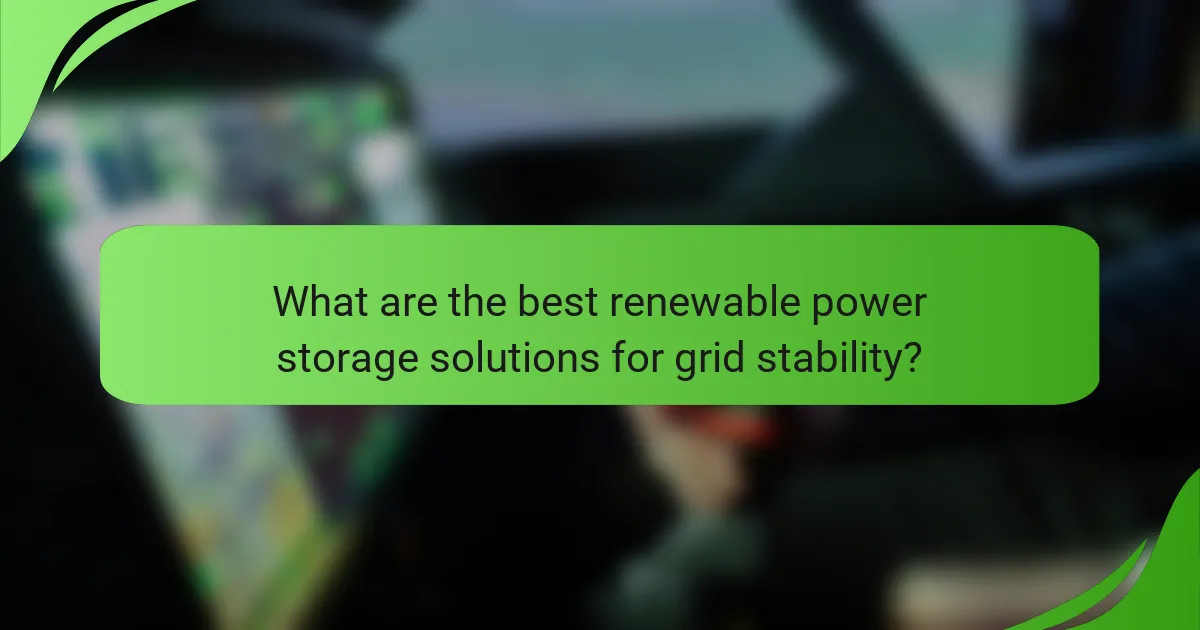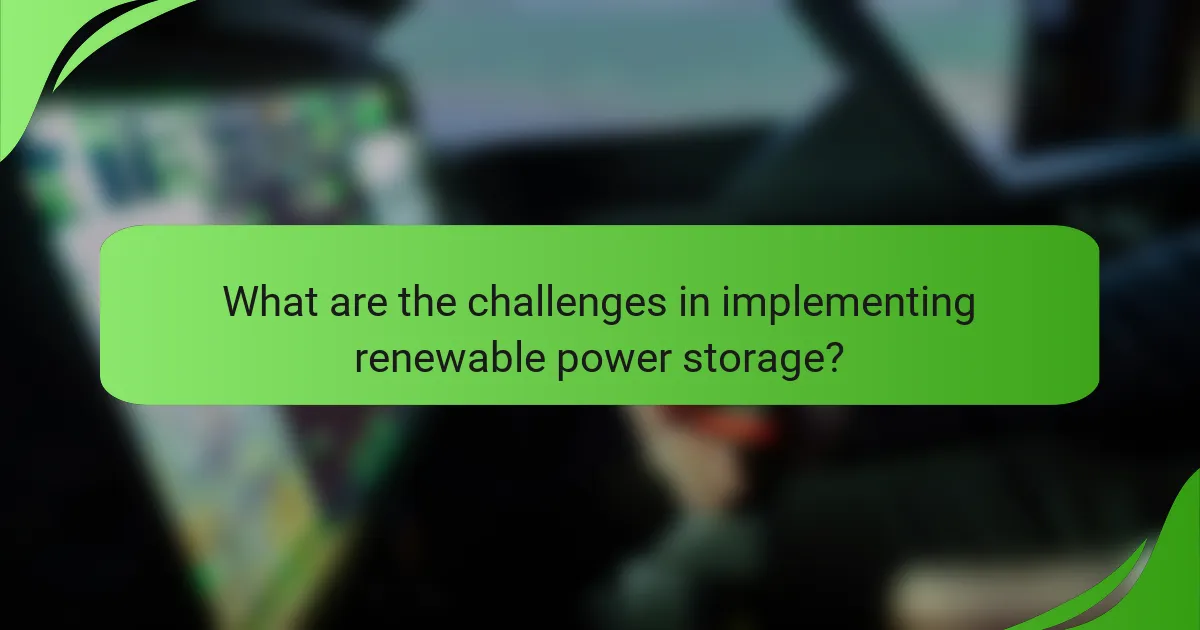Renewable power storage solutions are essential for enhancing grid stability and reliability, enabling the effective integration of renewable energy sources. Technologies such as Battery Energy Storage Systems, Pumped Hydro Storage, and Compressed Air Energy Storage play a vital role in balancing supply and demand, ensuring a consistent power flow. By providing a buffer against fluctuations, these systems contribute to a more resilient and efficient energy grid.

What are the best renewable power storage solutions for grid stability?
The best renewable power storage solutions for grid stability include Battery Energy Storage Systems (BESS), Pumped Hydro Storage, Compressed Air Energy Storage (CAES), Flywheel Energy Storage, and Thermal Energy Storage. Each of these technologies plays a critical role in balancing supply and demand, enhancing reliability, and ensuring the efficient use of renewable energy sources.
Battery Energy Storage Systems (BESS)
Battery Energy Storage Systems (BESS) are among the most versatile solutions for grid stability. They store energy in chemical form and can quickly discharge it to the grid, providing immediate support during peak demand or outages. Lithium-ion batteries are the most common type, but other technologies like flow batteries are gaining traction.
When considering BESS, evaluate factors such as capacity, discharge duration, and lifecycle costs. Systems can range from small residential units to large-scale installations capable of supporting entire communities. Proper sizing and management are crucial to maximize efficiency and minimize costs.
Pumped Hydro Storage
Pumped Hydro Storage is a well-established method for energy storage, utilizing two water reservoirs at different elevations. During low demand, excess energy is used to pump water uphill, and during high demand, the stored water is released to generate electricity. This method can provide large-scale storage and is highly efficient, often exceeding 70% efficiency.
However, the feasibility of pumped hydro depends on geographical conditions, as it requires suitable sites with significant elevation differences. While it can provide long-duration storage, the initial investment and environmental impact must be carefully assessed.
Compressed Air Energy Storage (CAES)
Compressed Air Energy Storage (CAES) involves compressing air in underground caverns or tanks during periods of low demand and releasing it to generate electricity when needed. This technology can provide large-scale energy storage and is particularly useful for balancing intermittent renewable sources like wind and solar.
CAES systems can achieve efficiencies around 50-70%. However, they require specific geological formations for underground storage and may involve additional costs for heating the compressed air before expansion to improve efficiency.
Flywheel Energy Storage
Flywheel Energy Storage systems store energy in a rotating mass. When energy is added, the flywheel speeds up, and when energy is needed, it slows down, releasing stored energy back to the grid. Flywheels can respond almost instantaneously, making them ideal for frequency regulation and short-term energy supply.
These systems are highly durable and have low maintenance costs, but they typically have shorter storage durations compared to other technologies, usually ranging from seconds to a few minutes. They are best suited for applications requiring rapid response rather than long-term energy storage.
Thermal Energy Storage
Thermal Energy Storage systems store energy in the form of heat, using materials like water, molten salt, or concrete. This stored heat can later be converted back into electricity or used directly for heating applications. This method is particularly effective in conjunction with concentrated solar power plants.
Thermal storage can provide significant capacity and is often more cost-effective for long-duration storage compared to batteries. However, it requires careful management of heat losses and may involve higher upfront infrastructure costs. Understanding the thermal characteristics of the storage medium is essential for optimizing performance.

How do renewable power storage solutions enhance reliability?
Renewable power storage solutions enhance reliability by providing a buffer that balances energy supply and demand, ensuring a consistent power flow. These systems help stabilize the grid, making it more resilient to fluctuations and integrating renewable energy sources more effectively.
Mitigating supply-demand imbalances
Renewable power storage systems, such as batteries and pumped hydro storage, play a crucial role in addressing supply-demand imbalances. By storing excess energy generated during peak production times, these systems can release power when demand exceeds supply, thus maintaining grid stability.
For example, during sunny days, solar panels may produce more energy than needed. Storage solutions can capture this surplus, which can then be utilized during evening hours when demand rises, effectively smoothing out the energy supply curve.
Improving grid resilience
Grid resilience is enhanced through renewable power storage by providing backup power during outages or unexpected demand spikes. Storage systems can quickly discharge energy, helping to prevent blackouts and maintain service continuity.
In regions prone to extreme weather, having robust storage solutions can be vital. For instance, during storms that disrupt traditional power sources, stored energy can keep critical infrastructure operational, ensuring essential services remain available.
Facilitating renewable energy integration
Integrating renewable energy sources like wind and solar into the grid is facilitated by storage solutions, which help manage their intermittent nature. These systems allow for the capture of energy when production is high, which can be released when generation drops.
In practice, this means that utilities can rely more on renewables without compromising reliability. For instance, a grid that incorporates storage can achieve higher percentages of renewable energy usage, often exceeding 30-40%, without risking stability.

What factors should be considered when choosing a storage solution?
When selecting a renewable power storage solution, key factors include cost-effectiveness, scalability, environmental impact, and technology maturity. Each of these elements plays a crucial role in ensuring that the chosen system meets both current and future energy demands efficiently.
Cost-effectiveness
Cost-effectiveness is vital when evaluating storage solutions, as it directly impacts overall project feasibility. Consider both initial capital expenditures and ongoing operational costs. For instance, lithium-ion batteries may have higher upfront costs but offer lower maintenance expenses over time.
It’s also essential to assess the total cost of ownership, which includes installation, lifecycle maintenance, and potential incentives or subsidies available in your region. Comparing different technologies can help identify the most economically viable option.
Scalability
Scalability refers to the ability of a storage solution to grow with increasing energy demands. A scalable system allows for incremental investments, enabling users to expand capacity as needed without complete overhauls. This flexibility is particularly important in rapidly evolving energy markets.
For example, modular battery systems can be expanded by adding more units, while pumped hydro storage may require significant infrastructure changes. Evaluate your future energy needs to ensure the chosen solution can adapt accordingly.
Environmental impact
The environmental impact of a storage solution encompasses both its carbon footprint and resource usage. Assess the lifecycle emissions of the technology, including production, operation, and disposal phases. Solutions like flow batteries may offer lower environmental impacts compared to traditional lead-acid batteries.
Additionally, consider the sourcing of materials and their sustainability. Opting for technologies that utilize abundant and recyclable materials can minimize ecological harm and align with broader sustainability goals.
Technology maturity
Technology maturity indicates how well-established and reliable a storage solution is. Mature technologies, such as lithium-ion batteries, have undergone extensive testing and have proven performance metrics, making them a safer choice for immediate implementation.
Conversely, emerging technologies may offer innovative advantages but come with higher risks and uncertainties. Conduct thorough research on the track record of the technology and consult industry experts to gauge its readiness for deployment in your specific context.

What are the challenges in implementing renewable power storage?
Implementing renewable power storage faces several challenges that can hinder its effectiveness and widespread adoption. Key issues include high initial investment costs, regulatory hurdles, and technological limitations that affect the efficiency and reliability of storage solutions.
High initial investment
The high initial investment required for renewable power storage systems can be a significant barrier for many stakeholders. Costs for technologies like lithium-ion batteries or pumped hydro storage can range from thousands to millions of dollars, depending on the scale and application.
Investors and operators must weigh these upfront costs against long-term savings and benefits. Financial incentives, such as government grants or tax credits, can help mitigate these expenses, but they often vary by region and may not be available in all areas.
Regulatory hurdles
Regulatory hurdles can complicate the implementation of renewable power storage solutions. Different regions have varying regulations regarding energy storage, grid interconnection, and market participation, which can create confusion and delays.
Stakeholders should familiarize themselves with local regulations and engage with policymakers to advocate for supportive frameworks. Understanding the permitting process and compliance requirements is essential to avoid costly setbacks during project development.
Technological limitations
Technological limitations pose challenges to the efficiency and scalability of renewable power storage systems. Current technologies may not provide the necessary energy density, discharge rates, or lifespan to meet the demands of a rapidly evolving energy landscape.
Investing in research and development can help address these limitations, but stakeholders should also consider existing technologies that offer reliable performance. For example, while lithium-ion batteries are widely used, alternatives like flow batteries or solid-state batteries may provide better longevity and safety in specific applications.

How do different regions implement storage solutions?
Regions implement storage solutions to enhance grid stability and reliability by utilizing various technologies suited to their specific energy needs and resources. These solutions often include battery storage, pumped hydro, and other innovative methods tailored to local conditions.
California’s battery initiatives
California has emerged as a leader in battery storage initiatives, primarily focusing on lithium-ion technology. The state has set ambitious goals to achieve a significant percentage of its energy from renewable sources, necessitating robust storage solutions to manage intermittent supply.
Key projects include large-scale battery installations, such as the Hornsdale Power Reserve, which can provide grid support during peak demand. These initiatives are often incentivized through state programs and regulations, making them financially viable for both public and private entities.
Germany’s pumped hydro projects
Germany relies heavily on pumped hydro storage to balance its grid, particularly given its substantial investment in wind and solar energy. This method involves using excess energy to pump water to a higher elevation, which can then be released to generate electricity when demand peaks.
With numerous facilities across the country, Germany’s pumped hydro projects can provide substantial storage capacity, often measured in gigawatt-hours. These projects are crucial for maintaining grid stability, especially as the country transitions away from fossil fuels and increases its renewable energy share.
